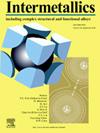Influence of texture on the superelasticity and elastic modulus of Ti-20Nb-10Zr alloy
IF 4.3
2区 材料科学
Q2 CHEMISTRY, PHYSICAL
引用次数: 0
Abstract
A new Ti-20Nb-10Zr alloy with e/a of 4.2 was designed for biomaterials. The superelasticity (SE), elastic modulus and microstructure of this alloy with different cold rolling ratios (CRRs) and 1173 K/30min solution treatment (ST), CRR89.5 %-ST and CRR91 %-ST and CRR94.5 %-ST, were investigated by conventional and cyclic tensile tests and electron backscatter diffraction (EBSD). This alloy consisted of β phase only at room temperature after solution treatment at 1173 K for 30 min. The fracture strain of this alloy was greater than 40 %. EBSD observation showed that the recrystallization texture changed significantly with the increase of CRR from 89.5 % to 94.5 %. It was initially a weak {112}< 241 > texture, and then transformed into a strong {111}<112> texture and a weak {223}<341> texture, and finally formed a super strong {111}<110> texture. The formation of recrystallization texture depends on the mechanism of oriented nucleation or oriented growth. The CRR94.5 %-ST is equipped with high SE of 3 % and low elastic modulus of 50.5 GPa at the same time. The {111}<110> texture is not only beneficial to improve SE but also favorable to decrease elastic modulus. Thus, these results indicate that tailoring {111}<110> texture could be considered as promising technique for developing biomedical β titanium alloys with high superelasticity and low elastic modulus.
求助全文
约1分钟内获得全文
求助全文
来源期刊

Intermetallics
工程技术-材料科学:综合
CiteScore
7.80
自引率
9.10%
发文量
291
审稿时长
37 days
期刊介绍:
This journal is a platform for publishing innovative research and overviews for advancing our understanding of the structure, property, and functionality of complex metallic alloys, including intermetallics, metallic glasses, and high entropy alloys.
The journal reports the science and engineering of metallic materials in the following aspects:
Theories and experiments which address the relationship between property and structure in all length scales.
Physical modeling and numerical simulations which provide a comprehensive understanding of experimental observations.
Stimulated methodologies to characterize the structure and chemistry of materials that correlate the properties.
Technological applications resulting from the understanding of property-structure relationship in materials.
Novel and cutting-edge results warranting rapid communication.
The journal also publishes special issues on selected topics and overviews by invitation only.
 求助内容:
求助内容: 应助结果提醒方式:
应助结果提醒方式:


